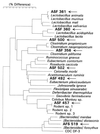Phylogeny of the defined murine microbiota: altered Schaedler flora
- PMID: 10427008
- PMCID: PMC91493
- DOI: 10.1128/AEM.65.8.3287-3292.1999
Phylogeny of the defined murine microbiota: altered Schaedler flora
Abstract
The "altered Schaedler flora" (ASF) was developed for colonizing germfree rodents with a standardized microbiota. The purpose of this study was to identify each of the eight ASF strains by 16S rRNA sequence analysis. Three strains were previously identified as Lactobacillus acidophilus (strain ASF 360), Lactobacillus salivarius (strain ASF 361), and Bacteroides distasonis (strain ASF 519) based on phenotypic criteria. 16S rRNA analysis indicated that each of the strains differed from its presumptive identity. The 16S rRNA sequence of strain ASF 361 is essentially identical to the 16S rRNA sequences of the type strains of Lactobacillus murinis and Lactobacillus animalis (both isolated from mice), and all of these strains probably belong to a single species. Strain ASF 360 is a novel lactobacillus that clusters with L. acidophilus and Lactobacillus lactis. Strain ASF 519 falls into an unnamed genus containing [Bacteroides] distasonis, [Bacteroides] merdae, [Bacteroides] forsythus, and CDC group DF-3. This unnamed genus is in the Cytophaga-Flavobacterium-Bacteroides phylum and is most closely related to the genus Porphyromonas. The spiral-shaped strain, strain ASF 457, is in the Flexistipes phylum and exhibits sequence identity with rodent isolates of Robertson. The remaining four ASF strains, which are extremely oxygen-sensitive fusiform bacteria, group phylogenetically with the low-G+C-content gram-positive bacteria (Firmicutes, Bacillus-Clostridium group). ASF 356, ASF 492, and ASF 502 fall into Clostridium cluster XIV of Collins et al. Morphologically, ASF 492 resembles members of this cluster, Roseburia cecicola, and Eubacterium plexicaudatum. The 16S rRNA sequence of ASF 492 is identical to that of E. plexicaudatum. Since the type strain and other viable original isolates of E. plexicaudatum have been lost, strain ASF 492 is a candidate for a neotype strain. Strain ASF 500 branches deeply in the low-G+C-content gram-positive phylogenetic tree but is not closely related to any organisms whose 16S rRNA sequences are currently in the GenBank database. The 16S rRNA sequence information determined in the present study should allow rapid identification of ASF strains and should permit detailed analysis of the interactions of ASF organisms during development of intestinal disease in mice that are coinfected with a variety of pathogenic microorganisms.
Figures

References
-
- Baker D E. The commercial production of mice with a specified flora. Natl Cancer Inst Mongr. 1966;20:161–166. - PubMed
-
- Caccavo F, Jr, Coates J D, Rosselo-Mora R A, Ludwig W, Schleifer K H, Lovely D R, McInerney M J. Geovibrio ferrireducens, a phylogenetically distinct dissimilatory Fe(III)-reducing bacterium. Arch Microbiol. 1996;165:370–379. - PubMed
-
- Collins M D, Lawson P A, Willems A, Cordoba J J, Fernandez-Garayzabal J, Garcia P, Hippe J, Farrow J A E. The phylogeny of the genus Clostridium: proposal of five new genera and eleven new species combinations. Int J Syst Bacteriol. 1994;44:812–826. - PubMed
Publication types
MeSH terms
Substances
Associated data
- Actions
- Actions
- Actions
- Actions
- Actions
- Actions
- Actions
- Actions
- Actions
- Actions
Grants and funding
LinkOut - more resources
Full Text Sources
Other Literature Sources
Molecular Biology Databases
Miscellaneous

